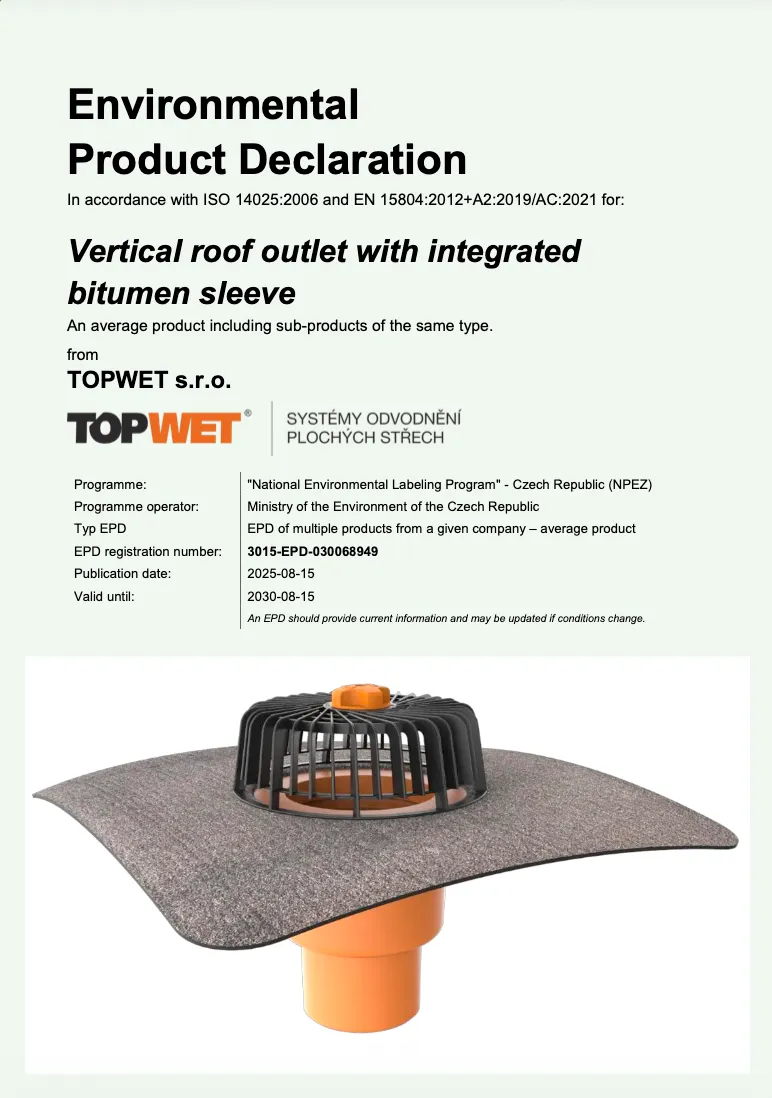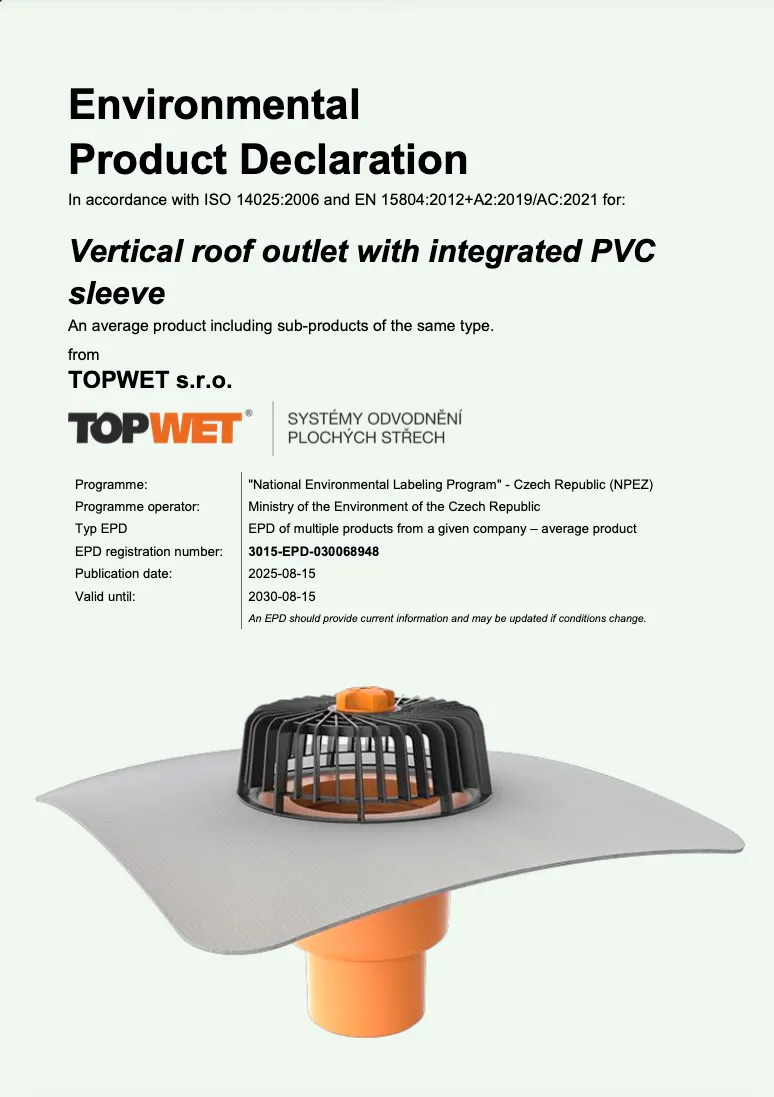Technical information
.svg)
VÝPOČET HLAVNÍHO ODVODNĚNÍ
VÝPOČET POJISTNÉHO ODVODNĚNÍ
IČ: ____..27377377
DIČ: ___CZ27377377
Pozn. U kapacity vpustí nebo chrličů jsou v závorce uváděny normálové hladiny vody na střeše.
Pozn. U kapacity vpustí nebo chrličů jsou v závorce uváděny normálové hladiny vody na střeše.
V případě dalších dotazů nebo upřesnění jsme k dispozici na kontaktech technické podpory.
Telefon: +420 777 701 241
E-mail: [email protected]

The roof inlet is always like the lower part (therefore it has an outer diameter in the name for connection to the downstream rain pipe) and the inlet extension is always installed in the drain (the mouth of the drain, that is, its upper part is universal approx. 130 mm and it does not matter if the inlet is DN 70, 100 or 125 — the drain attachment can be inserted into these diameters). The opposite cannot be done.

It does not drain, a seal must always be inserted into the mouth of the drain in case of heavy rains, when the rain pipe becomes clogged and the water could re-enter the thermal insulation layer by re-inflation. For water drainage from the vapor barrier, we have a special product, a separate small inlet located next to the rain drain, with a detection transparent flask and a check valve protecting the entire system against water swelling.

During construction, it serves as a reliable temporary drainage (subsequent layers of the roof sheathing can be realized calmly half a year later). It is important for the construction itself as a reliable connection to the vapor barrier layer, so the vapor barrier is not perforated at the place of installation of the drain and there can be no moisture disturbance.

As a rule, the inlet (lower part) is heated, due to the ease of bringing the supply cable under the ceiling, where it is further connected by electricians. We can provide heating of the upper part, but this creates unnecessary technical problems with how to bring the supply cable under the ceiling.

The minimum height of thermal insulation at the site of the drain is 40 mm. With a smaller layer of thermal insulation, the extension — due to the design — can no longer be retracted.

Samoregulační vpusti jsou vybaveny polovodičovým systémem vyhřívání a svůj výkon si regulují v závislosti na okolní teplotě, ale neumí se samy úplně vypnout. Užité napětí je 230 V / 50 Hz, tedy není potřeba pro zapojení zakoupit drahý transformátor.

- wiring on a stationary without a switch (we do not recommend using electricity even in the summer)
- manual switch, by which we interrupt the phase and thus the supply of electricity during the summer period
- time socket (annual)
- Thermostat, which is ideally set in the range of +3 °C to -10 °C, or if only one temperature can be set, then to +3 °C. In practice, this means that as soon as the temperature drops below 3 °C, the thermostat starts heating the inlet and prevents freezing at hazardous temperatures around 0 °C.

In the case where the roof drain is not heated, the roof vent does not need to be confused with a heated option, but you just need to purchase a heating kit. This kit includes a self-regulating heating cable for alternating voltage 230 V/50 Hz (heating length 0.4 m and 0.6 m respectively for XL variants, supply cable length 1.5 m), 2 pieces of plastic mounting tapes for fixing the cable to the inlet body and aluminum adhesive tape to limit heat loss.

The cable has no sensor, it regulates its performance using a semiconductor layer depending on the ambient temperature.

The flap is designed for places with free air circulation (outdoor terraces and balconies). The flap does not have 100% efficiency, has a higher drain capacity than a siphon and a lower risk of clogging.
The siphon is intended for confined spaces and places where 100% effectiveness of the anti-odor measure is required. The siphon has a 100% effect, a lower drain capacity than a flap and a higher risk of clogging with dirt.

Yes, all patio accessories are fully compatible with terrace drains, classic roof drains and extensions for roof drains.

Sealing cuffs can also be produced in RAL color when you order larger quantities. Therefore, in order to avoid color mismatch of individual manufacturers, the best option is for the customer to supply the foil in the desired shade himself. The requirements for the foil are such that it must be a foil without a reinforcing insert (so-called detail film).

The body of such products is made of PVC material. We do not dye the plastic itself in production, the basic colors are white and black. It is possible to paint the PRIMER element with paint and then paint on plastics in the desired RAL shade. The best solution is to apply paint directly on the construction site, this will avoid problems with the fact that the element will be scuffed with unprofessional handling and damage to the color coating.

In order to install the roof drain in the gutter, it is possible to make adjustments in the production of the drain in such a way as to reduce the size of the anchor plate. Each type of drain allows adjustments in different ranges, so do not hesitate to contact our technical department with this issue. These types of products are not in stock and are made to order.

The body of the inlet must always be fixed in the supporting layer, otherwise the suction of the wind may tear the drain from the connected pipe. Exceptions are cases where the inlet is two-stage and glued and aggravated systems are used - then the attachment does not need to be anchored, as this would make no sense.

Polyamide is a rigid, heavy-duty plastic that can be machined very well. The production technology guarantees the product of high toughness, with good sliding properties, high abrasion resistance and good chemical stability.

The slats of the new protective basket are not up to the bottom because to increase the self-cleaning ability of the protective basket, and small debris such as small leaves, etc. could freely drain into the sewer, and the bin only caught dirt that could clog the sewer.

For drains with integrated cuff, the waterproofing cuff is tightly pressed between the drain body and the upper flange, and the two parts are tightly welded by ultrasound. The entire connection process takes place directly in production, and the manufacturer assumes all responsibility for the watertightness of this critical detail.
During assembly, the advantage is that the drain is not screwed together, but the inlet is pulled out of the box and directly inserted into the mounting hole, the cuff is buckled and closed.
For drains with a screw flange, the manufacturer supplies the inlet as several separate elements, and the connection to each other takes place directly on the construction site, and very often errors occur. Gutters with a screw flange may not tighten enough or, conversely, drag, and with both, overflow into the roof composition may occur. Even if the screws are tightened correctly, the tightness of the bolts must also be checked at the drains outside the inspection and cleaning of the protective baskets.


.webp)

